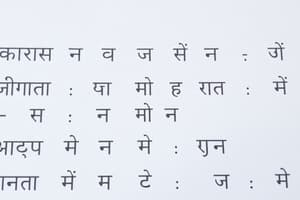Podcast
Questions and Answers
कौनसा इस्त्रीलिंग है?
कौनसा इस्त्रीलिंग है?
- कमरा
- गुलाब (correct)
- किताब
- मस्जिद
'किताब' का बहुवचन क्या होगा?
'किताब' का बहुवचन क्या होगा?
- किताबी
- किताबों (correct)
- किताबा
- किताबाएं
'मामी' शब्द के अंत में 'iyya' जोड़ने पर क्या बन जाएगा?
'मामी' शब्द के अंत में 'iyya' जोड़ने पर क्या बन जाएगा?
- मामीया (correct)
- मामीन
- मामियों
- मामिया
हिंदी में 'पुस्तक' का विलोम क्या है?
हिंदी में 'पुस्तक' का विलोम क्या है?
'पेड़' किसलिंग में आता है?
'पेड़' किसलिंग में आता है?
'पति' के समानार्थी क्या है?
'पति' के समानार्थी क्या है?
कौन सा विधिवाचक सबसे सही है?
कौन सा विधिवाचक सबसे सही है?
सर्वनाम क्या प्रदर्शित करते हैं?
सर्वनाम क्या प्रदर्शित करते हैं?
Study Notes
Language Structure of Hindi
Hindi is one of the official languages of India and has its roots in Sanskrit, which was widely used during ancient times. It's part of the Indo-Aryan family of languages, which includes Urdu, Bengali, Gujarati, Marathi, Nepali, and many others. This section will delve into the key aspects of Hindi's grammatical system, including word formation, sentence construction, and other important elements that make up this beautiful language.
Word Formation
In Hindi, like most Indian languages, words are formed using suffixes rather than prefixes. For example, 'kitaab' means book while 'kitabaanaa' means books, where the plural form is created by adding '-aa' after the root word 'kitaab'. This morphologically inflective ability allows speakers to convey more information in fewer syllables. Additionally, inflectional affixes can change the meaning of words drastically. For instance, if you add '-eemaa' to the end of 'mama', it becomes 'maamii', which translates to grandma, a grandmother. On the contrary, when you add 'iyya' at the end of 'maamii', it changes to 'maymmiyaa', indicating a mother-in-law.
Noun Gender
In Hindi, nouns have gender specified by their endings; masculine nouns usually have no final consonant, feminine nouns end with -i, -ae, -ye, etc., neuter with -u, -um, -ummi, etc. Some examples from each group might be:
Masculine: khwaab = dream, dard = pain Feminine: shahar = city, baakaaya = body Neuter: haqiqat = truth, raheem = merciful
These morphological differences also carry over when these nouns become possessive forms, as well as in past tense verbal forms, resulting in different conjugations depending upon the type of noun being referred to.
Verbs
Unlike English, Hindi does not rely heavily on auxiliary verbs. Instead, there exists only two main tenses—simple present and simple future. To show progressive action, Hindi uses a combination of a verb stem ending with –nna + perfect participle. So, if we wanted to say someone is studying now, we would need to construct the following phrase: ye log saadhan kar raha hai (meaning they study) and jo saadhan karne wala hai (meaning the person who studies).
Pronouns
Pronouns in Hindi are complex since they indicate both gender and number. Examples of personal pronouns include maani hoon (I am), tum ho (you are), yeh sabhi hain (these all are), vo hamare liye chahiye (that is needed for us); maanta hoon (I listen), tum sunoge (you hear), yeh sabhi samjhenge (all these understand). These words vary based on whether they refer to singular or multiple people.
Conclusion
The Hindi language structure is quite unique due to its reliance on inflections instead of prepositions. Its sentence structures differ significantly from those found in Western European languages. Learning Hindi requires understanding how the basic building blocks interact together within a given context while keeping track of the inherent gender specificity of nouns. Once mastered though, the ability to speak Hindi opens doors to a vibrant culture filled with stories, poetry, and traditions worth exploring.
Studying That Suits You
Use AI to generate personalized quizzes and flashcards to suit your learning preferences.
Description
इस क्विज़ में हिंदी भाषा की व्याकरणिक प्रणाली, शब्द गठन, वाक्य निर्माण, और अन्य महत्वपूर्ण पहलुओं पर प्रकाश डाला जा रहा है। यह सेक्शन हिंदी की मौलिक संरचना के महत्वपूर्ण पहलुओं पर जाएगा और भाषा को समझने की महत्वपूर्णता को उजागर करेगा।




